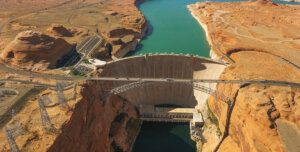
Ghena Alhanaee, who is one of the few women in the U.A.E. pursuing a Ph.D. envisions a new era of cooperation between countries that share the same body of water. Photo / Christina Boemio
Ghena Alhanaee, a Ph.D. candidate at the USC Viterbi School of Engineering, has been named by the MIT Technology Review to the 2020 TR-35 list of the world’s leading innovators under 35.
Alhanaee – who studies civil and environmental engineering under the supervision of Professor Najmedin Meshkati, a renowned expert in human factors and safety culture – is the first USC doctoral student to have made MIT Technology Review’s list twice. She was named one of the top innovators under 35 years of age for the Middle East and North Africa on October 31, 2019. She is also the first USC student to earn this distinction as a currently enrolled student.
Set to defend her dissertation at the end of summer 2020, Alhanaee focuses her research on environmental sustainability, energy resources, water and food security. She is designing a framework to prevent and prepare the Persian Gulf region, including her native United Arab Emirates (U.A.E.), in the event of a disaster.
“It is wonderful to see that another talented USC Viterbi PhD student has been recognized in the prestigious TR35 list,” said Dean Yannis C. Yortsos. “Gheena’s work helps addressing the complexity and interdependence of vital energy and water resources in a world that is more interconnected than ever before. Her TR35 recognition is a testament to her ingenuity and the vision to engineer a better world for all humanity.”
The Gulf is an umbilical cord that connects Iran, Oman, the United Arab Emirates, Saudi Arabia, Bahrain, Kuwait, Qatar and Iraq. It is estimated that by 2030, over 50 million people in this region will depend on desalination of Gulf waters for their daily water supply.
“We are talking about the value of water to an entire water-starved region,” Alhanaee said. “One-third of oil production is in The Gulf and so is half of the world’s desalination. Now, add nuclear energy to the mix with one large nuclear reactor operating in Iran, four being built in the U.A.E. and at least two planned in Saudi Arabia.”
If a disaster occurs in either of these interdependent sectors, be it nuclear or desalination plants, or an oil rig, it can devastate the region as it happened in The Persian Gulf War Oil Spill of 1991 – the word’s largest known oil spill.
“Now, consider that some of these countries only have a two- to three-day emergency supply of water,” Alhanaee said.
Her solution involves a lot of detective work, engineering and diplomacy. First, she pieces together data from accident reports, such as oil spills in the U.S., to create the anatomy of an accident.
“We’re looking at all of these compounded factors,” she said. “Was training an issue? Was there a skipped procedure? How many times did any of these occur and in what combinations? We take all of this qualitative data and make it quantitative. If the data is not available, we turn to subject matter experts to help us fill in the gaps.”
With this system dynamics approach, Alhanaee is able to create a more complete picture for decision makers in The Gulf. Then, her work only grows in complexity as she tries to bring competing stakeholders together to design and enact better risk mitigation strategies.
“We’re just setting the foundation, proving the methodology” she said, “We then have to look at the entire cluster such as the proximity of oil platforms and nuclear power plants to desalination plants, shared connections and resources.”
She envisions a linked emergency response plan, not just across industries but also across countries, an effort that has put her in the vanguard of “engineering diplomacy” — the intersection of engineering, technology and scientific research with foreign policy.
“We are talking about the value of water to an entire water-starved region.”
Ghena Alhanaee
“I truly believe that Ghena’s unprecedented research topic addresses one of the most important and crucial issues affecting the future of the Persian Gulf and its eight littoral countries with a population of over 160 million people,” said Meshkati, her Ph.D. advisor in the Sonny Astani Department of Civil and Environmental Engineering. “I am confident that the impact of her research can significantly help to prevent and mitigate the dire consequences of a major disaster in a geopolitically and ecologically sensitive region of the world.”
Motivated by Alhanaee’s research, a confluence of global experts and senior officials in nuclear energy from the U.A.E., Pakistan, the U.S. Nuclear Regulatory Commission, U.S. Department of Energy, the World Association of Nuclear Operators (WANO), U.S. utility companies and the International Atomic Energy Agency (IAEA) have come together in a single doctoral dissertation to advise Alhanaee and Meshkati.
“Step by step, by highlighting interdependencies, we are building trust in a region where trust can’t just be an asset, it’s the foundation upon which everything is built,” Alhanaee said.
Read more about Alhanaee in MIT’s Tech Review.
Published on June 17th, 2020
Last updated on January 11th, 2021











